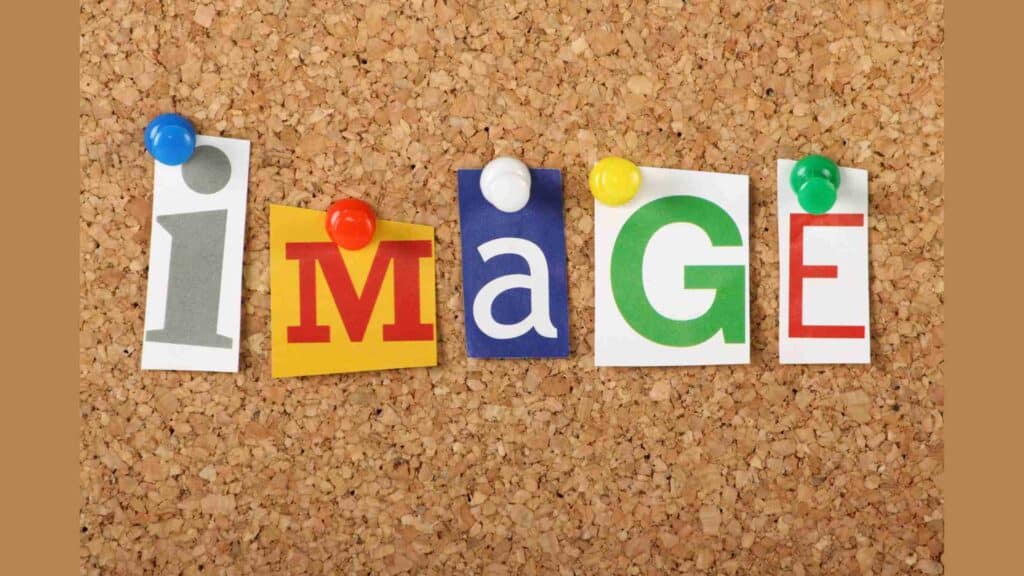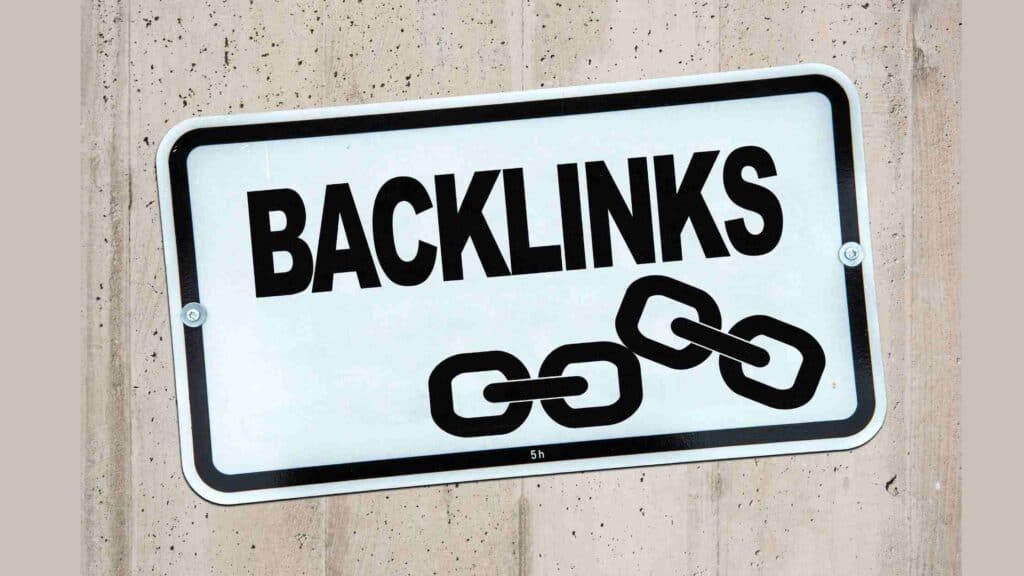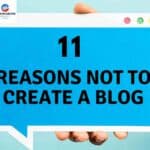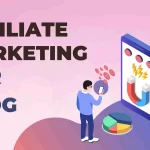What exactly is a Blog? in short, “An Internet Diary.“
There are currently over 570 million blogs on the Internet, with that number expected to grow in the coming years.
Many people have a strong desire to start a blog but have no idea how to get started.
This is primarily what motivates me to write this guide in order to assist as many people as possible who may find themselves in this situation.
- What exactly is a blog, and What distinguishes it from a website?
- Why is it significant for SEO?
- How do I start and configure my blog?
- How do you manage your blog to achieve rapid success?
These are some of the questions that I will answer precisely and clearly in this guide.
So let’s get started!
What exactly is a blog?

A blog can be thought of as an informational website with articles displayed in chronological order.
These articles are often written by one person or a group of people who share their views on a particular topic.
Every day, approximately 2 million blog posts are published on the Internet:
However, blogs have entirely evolved. Bloggers now blog for a variety of reasons and on a wide range of topics/niches. For example, consider the following popular blogging niches:
- Natural reference
- Way of life
- Health and Fitness
- Food / Cooking
- Personal Finance
- Beauty
- Travel
- Technology
- Entrepreneurship
- Immovable
- Personal development
As you can see, you can create a blog on almost any topic.
Blog definition
To be very clear about the broad concept of what a blog is, let me first explain where this little word comes from, in case you didn’t know.
Jorn Barger coined the term “web log” or “weblog” (weblogs in plural) in 1997 to describe the act of “annotating/registering the web” ( logging the web ).
And in 1999, Peter Merholz separated the word into “we blog,” which means that it will be shortened to blog from then on.
In other words, the term blog is an abbreviation for web log, which means “web log”.
As a result, the blog’s primary meaning is that of a digital blog or diary where content is “recorded” chronologically.
What is the function of a blog?
The reasons for starting a blog are numerous. This could be for personal or professional (business) reasons.
Blogs for businesses, projects, or anything else that can make money have one goal: to rank higher in Google SERPs, to reach out to potential customers, and to capture their attention.
Companies’ websites would be invisible without blogs (unless they invested in advertising), whereas running a blog would make them findable and competitive. They boost your traffic by directing qualified leads to your website.
When you post quality blog posts frequently, your website will be more likely to be discovered and visited.
As a result, the primary goal of a blog is to:
- To increase the visibility of your website;
- to generate quality leads on your site;
- to connect with your target audience.
When you include a strong call-to-action (CTA) in your content, you can convert 4% of visitors into high-quality leads.
A blog also allows you to build a brand and showcase your niche authority.
You’ll get the trust of your audience if you create informative and engaging content using your niche knowledge.
Good blogging increases the credibility of your business, which is critical if it is not well-known enough. It offers both online visibility and niche authority.
Blog Structure
Blog appearance has evolved, and blogs now include a wide range of elements and widgets.
Most blogs, however, retain some standard features and structures.
Here are the standard features that a regular blog will include:
- Menu or navigation bar in the header
- Highlighted or most recent blog posts in the main content area
- Sidebar containing social profiles, favourite content, or a call to action
- Footer with relevant links such as disclaimers, privacy policies, contact pages, and so on.
what is the difference between a blog and a website?
Many people are still perplexed as to the distinction between a blog and a website! Choosing between the two has become even more complicated in recent years.
Many businesses also incorporate blogs into their websites, which further confuses the two.
Blogs are frequently updated because there is always new information available.
A food blog that shares meal recipes is an excellent example, as is a business that writes about industry news.
Furthermore, blogging encourages reader interaction. The latter have the opportunity to comment on and express their opinion on the online content. Blog owners regularly add new blog posts to their sites.
On the other hand, websites are made up of content presented on static pages. Owners of static websites rarely update their pages.
In this visual, here’s a quick comparison of the two:
The following vital elements distinguish a blog post from a static website page:
- Date of publication
- An author citation
- In a signature, you can include categories and tags.
While not all blog posts include all these byline elements, static website pages do not have any.
A static site’s content will not change from one visit to the next from a visitor’s perspective.
Blog content, on the other hand, will offer something new every day, week, or month, depending on the blog owner’s posting schedule.
Misconceptions About Blogging
- 1. One of the most popular blogging misconceptions is that it should appeal to the most significant number of readers possible.
Your blog content should be written with your target audience in mind.
It is critical to conduct research in order to narrow your strategy to include content written for your niche.
Instead of trying to please everyone, educate and inform your target audience.
- 2. Another misconception about blogging is that it is all about quantity, as in “the more posts I publish, the more traffic my site will receive.”
Check out this comprehensive guide on the 11 Ugly Truths about blogging
Think about it again! Even though quantity should not be overlooked, the three following points are the most important:
- The approach
- Coherence
- The standard.
Because posts are written in a way that drives readers to conversion, a solid strategy will help your blog deliver results. Consistency fosters loyalty, and quality encourages trust.
After explaining some fundamental concepts on the blog, I need to explain some surrounding elements.
Types of blogs
There are various types of blogs. You can use blogs to teach something, tell stories, demonstrate your skills, disseminate information on a topic, sell products, or provide services…

As a result, the following is a valuable and exciting way to categorize all of the different types of blogs:
- Personal blog
- Blog for professionals
- Corporate blog
- Thematic or niche blog
Personal blog
This is possibly the most common type of blog, which is understandable given that the blog originated as a personal blog where you could share your experiences, ideas, thoughts, and so on.
In my case, I began in the world of blogs by creating a personal blog where I shared work experiences, ideas, personal opinions on current issues, and so on.
And, without a doubt, that blog was critical in the creation of this other blog that you are currently reading.
Blog for professionals
This type of professional blog has multiplied to the second type of blog after many have discovered its great benefits.
In many cases, they also seek to enhance their brand (often confused with the personal blog type).
Many people have decided to start “a good blog” where they can publish content that will help them.
For example, attract clients for their business or even make the blog their company (which is what I am doing).
And I emphasize the importance of developing one’s brand.
Because I believe that a professional blog, even if it provides information and objective data.
It should have a personal footprint, yes or no, because that is what distinguishes it from other blogs.
Corporate blog
It would be similar to the professional blog I previously described, but geared toward businesses, corporations, brands, and so on.
We also use the blog to “humanize” the image of these companies in many cases.
Later, you’ll see more examples of businesses and organizations that use blogs to provide value to users, build trust, and thus attract potential customers in a much less intrusive way than traditional advertising.
Thematic or niche blog
This refers to the type of blog that focuses on a specific topic and usually specializes in it (cinema, music, sport, a particular author, a current problem, a product or service, etc.).
You can already imagine an infinite number of blogs in this category.
When this type of blog aims to generate income, it is referred to as a niche blog (market niche).
If we are talking about a particular niche (for example, tennis shoes for children).
It is what is called a microniche, and when it comes to an extensive and general niche (for example, sneakers), it is what is called a macro niche.
Blog Terms – Blogging and Blogger
As stated in the chapter title, we will see two important secondary terms to Blog: Blogging and Blogger.
Let’s start with the term Blogging.
What exactly is blogging?
When several political blogs sprouted up in the early 2000s, blogs emerged in various forms.
Blogs with how-to manuals began to appear as well.
As a result, established institutions began to notice the distinction between journalism and blogging.
Blogging definition
Blogging is a set of abilities required to manage and supervise a blog. This entails providing a webpage with tools to help with the process:
- Publication
- writing
- Sharing
- and link to content on the Internet.
Why are blogs so popular?
It is important to note that the popularity of blogging is growing by the day!
Since their inception, blogs have grown in popularity as news organizations began to use them as tools for raising awareness and forming opinions.
They’ve evolved into a new source of information.
Businesses have discovered a positive way to improve their customer satisfaction levels through blogging.
Blogs assist businesses in informing their customers and prospects.
Furthermore, the more people who visit your blog, the greater your brand awareness.
Personal and niche bloggers saw an opportunity to reach out to more people interested in specific topics.
Visitors to your blog can comment and interact with you or your brand, allowing you to build a network of loyal followers.
Did you know that you can earn money by blogging? Once your blog has gained enough attention and followers, you can look for ways to monetize it.
You can sell products and offer services through your blog.
Let’s now take a deep look at the term “Blogger.“
What exactly is a blogger?
Bloggers have recently become well-known for a variety of reasons. For many, blogging has evolved into a second career or a side hustle.
People are increasingly choosing to join the ranks of bloggers as a result of this.
So, who exactly are bloggers?
Blogger Definition
A blogger is someone who manages and runs a blog. He also enjoys sharing aspects of his personal life with his audience.
He expresses his thoughts and knowledge on various topics for a specific audience.
Here are some examples:
Interior design
- arts
- Finance
- Woodwork
- SEO (like me)
and so on.
Bloggers are mobile and do not require a fixed location. They exist only on the Internet!
Why do so many people blog nowadays?
Do you want to start your blog? Yes!
Today, most people create blogs for various reasons. Every individual has a unique history to share.
Bloggers can communicate with a large number of people thanks to the Internet.
Blogs allow you to express your thoughts on any topic that interests you.
Bloggers will write about every activity that occurred during their day.
These activities can include simple things like:
- A soccer match
- A get-together with friends
- Climate change,
etc
Remember that as a blogger running your blog, you need to focus on the topics you are passionate about.
With this focus, you have the potential to become one of the best blogs on the web.
Do bloggers make money?
Bloggers make money, some much more than others, but it’s not a get-rich-quick scheme.
Before you can begin monetizing your blog, you must first improve your Google SERPs ranking as well as your niche influence.
These tasks are time-consuming and require good strategies, starting with quality content.
Money-making opportunities won’t come your way until you establish credibility in the field.
Here’s how to become a successful niche blogger:
- Privately or through Google AdSense, sell ad space on your blog.
- Become a private or public affiliate partner through advertising networks.
- Include product recommendations in your articles (like Amazon products)
- Offer your digital products and services for sale (higher return, but more significant time investment)
- Sell subscriptions to gain access to exclusive content or advice.
- Use your blog as a content marketing tool for your company, and so on.
If you’re starting a blog to market and grow an existing business, you’re unlikely to sell ad space or memberships.
Read our guide on “How To Monetize Your Blog With Affiliate Marketing.”
You can, however, create and begin selling exclusively digital products such as e-books.
In exchange for visitors’ email addresses, you can also offer online guides or courses as a lead capture tool:
How do you start your blog?
It takes a few steps to set up your blog. First, you must choose a name for your blog so that you can purchase a domain name.
Following that, you must select the best blogging platform for your requirements.
We recommend that you use a self-hosted platform. There are a few options for self-hosted platforms, but WordPress.org is the most popular.
If you need more information on this subject, please see this excellent guide on Best Blogging Platforms.
The next step is to select a hosting web service.
In the following article, I will discuss the next steps in greater detail.
How do you get started with your blog?
If you’re ready to start your business blog, the good news is that adding a blog section to your existing business website is relatively simple and inexpensive.
If your website is built with WordPress, adding a blog is as simple as adding an extra blank page.
Assuming you work with a web developer who manages your site’s content, you’ll need to discuss how to add a blog section to your site with them.
If you’re just getting started, I recommend the blogging platforms WordPress.com and Blogger, both of which allow you to get started for free:
However, in order to provide a consistent brand experience and maintain your professional image, You must purchase a unique domain name as well as hosting.
The majority of these blogging or site-building systems will walk you through the process of developing your own company blog.
It’s time to start blogging once you have a blog on your current site or have created a new blog from scratch.
Read our full guide on “Why Blogging is Worth it.” before starting.
To ensure your success, take the following steps:
Begin with a blog strategy.
A detailed strategy that guides the process is behind every great content marketing company. Blogs are no different!
To begin, describe the purpose of your blog. What motivates you to create blog content, and what do you hope to achieve?
Answering these questions will assist you in staying on track. as you brainstorm ideas for blog posts and create content.
This will help to ensure that you are providing value to your visitors at all times.
Next, consider who your target audience is. You can use buyer personas you’ve already created to identify people who will read your blog.
Otherwise, you can begin by describing your ideal customers.
It would be best if you considered your audience’s likes and dislikes, their most significant challenges and motivations, and basic demographics.
You must also decide how frequently you will post content and who will be involved in the process as part of your blogging strategy.
Determine key team members who can assist you in planning, creating, and promoting blog content.
Still, ensure that everyone is pulling in the same direction and understands their role in the blogging process.
Do keyword research.

Once you’ve established a general blogging strategy, you should concentrate on developing a keyword strategy.
Remember that your blog will play an essential role in your SEO efforts, so begin with a list of researched keywords on which to create content.
The objective is to generate a list of keywords. Relevant to your company and its product or service offering.
Read our complete guide on “22 Best Blogging Tools.”
Keyword research is a complex process. It would be best to research the keywords your target audience uses to find businesses like yours and consider the search volume and competition for those words.
For example, If you are competing against larger companies with much larger SEO budgets, you should concentrate on keywords with less competition.
You can use one of the following tools to determine keyword search volume and difficulty:
If your team does not include an SEO professional, your best bet would be to seek outside help for this part of the process.
Hiring an SEO company does necessitate an initial investment.
However, in the long run, it can help you save more time and money.
Furthermore, it assists you in avoiding costly mistakes, such as finding keywords that do not match your brand.
Develop topics and a content calendar
Now that you’ve compiled a list of keywords, you should begin brainstorming topics and developing a content calendar.
When brainstorming potential blog topics, start with your keyword list.
While SEO keywords are important, you should also ensure that your chosen topics add value to your readers.
Make sure that all the blog topics on your list are relevant to your target audience.
This entails concentrating on topics that address your target audience’s issues and challenges.
You can begin creating a content calendar once you have a list of topics.
Read our full guide on “The Best Mobile Apps for Bloggers.”
Your calendar will assist you in planning ahead of time and keeping you on track throughout the year to guarantee continuous content creation.
When creating your content calendar, anticipate relevant events or holidays for which you want to create content.
For example, the New Year is an excellent time to discuss developing new habits or improving various aspects of your life.
Whether you use an online content calendar or a basic spreadsheet, your content calendar should include the following information:
- Blog subject
- Keywords for SEO
- Content description
- Responsible individual
- The deadline
- The date of publication.
Feel free to add any other relevant information to your content calendar.
If you have multiple target audiences, you can include buyer personas for each.
You can also add information about how the content will be promoted, such as through social networks or emails.
Produce blog content
After you’ve devised a strategy, it’s time to start creating blog content!
It is preferable if you have previously decided who will be in charge of the following tasks on your team:
- The editorial staff’s
- research
- From the creation
- edition.
If you lack the financial means to engage a team, you may handle all of these activities on your own.
However, keep in mind that you will be highly cluttered, jeopardizing your work’s quality.
Otherwise, you can hire a low-cost content marketing service to assist you in creating the content.
If you have a team, you must implement a process that will assist each member in carrying out their mission.
Things should go pretty well once this process is established.
You should include images and other visual elements, in addition to written content, to help the reader understand the information you are presenting.
Create infographics to post alongside written content to educate further and engage your audience.
Distribute and promote your content
When the blog content is complete, it is time to publish it.
When publishing content on your website, keep essential SEO factors in mind, such as:
- The headings
- Subtitles
- Descriptions of metadata
These details assist search engines in better understanding your blog content and displaying it to the appropriate search engine users.
After you’ve published the content on your blog, you’ll need to promote it through various channels.
Begin by sharing links to the content on your social media pages.
Many businesses also use email marketing to promote new blog content.
Remember to include external links to relevant blog content in any new blog you create.
This improves SEO while providing more value to visitors who want to learn more about the topic.
How to set up your blog
There may still be some misconceptions regarding the difference between a blog and a standard website when it comes to design and structure.
Businesses can place their blog in relation to their main website in a variety of ways:
You can integrate your blog into your company’s website.
Your primary business website hosts an embedded blog.
It may show up on your website as a subdomain or subdirectory (company.com/blog) (blog.company.com).
This is the greatest choice for most small businesses when it comes to blog hosting. Because it provides a number of advantages:
An integrated blog helps to provide a seamless experience for your site visitors since they do not have to travel to a different site to read your blog material.
Because you can provide thought leadership content through your blog, visitors will recognize your brand as an industry leader.
Blog content allows you to add a lot more content to your site; the more content you have, the higher your search engine rankings will be.
Any backlinks that arrive at your blog posts will help improve your business site’s overall search engine optimization (SEO).
Aside from these advantages, an integrated blog is also less expensive to create and maintain. This makes it an appealing option for small businesses looking to launch a blog on a tight budget.
Your blog can serve as your business website.
Another option you may come across while browsing the web is a company whose primary website is its blog.
This is more common for professional bloggers who have a large following and have discovered a way to monetize their content, often through advertising and affiliate marketing.
This is not the best option if your business model does not revolve around a blog.
If you sell your products or services online, it’s best to have a main website with static page content that describes your products or services.
The blog’s purpose is to provide fresh content on topics your audience is interested in.
Your blog can be hosted on a different website.
Another option is to have a separate blog website from the central business website.
This is common when large companies try to create separate content marketing assets or when the industry thought leaders want to separate their blog content from site content—their company’s website.
In terms of logistics, a separate blog will have a completely different domain.
Your blog, for example, will have its URLs, such as financebodeblog.com rather than financebode.com/blog or blog.financebode.com.
Neil Patel is an excellent example of an entrepreneur with a blog and separate business sites.
Patel founded several companies with their websites, including CrazyEgg and Kiss Metrics.
However, he also blogs on his website, where he advertises his consulting services, and he has created a separate blog (quicksprout.com) in order to establish himself as an industry influencer.
Here are some reasons why you should separate your blog from your main company website:
- You want to differentiate yourself as a thought leader or industry expert from your corporate identity.
- You intend to cover a wide range of topics that may or may not be directly related to your company’s product or service offering.
- You want to create blog content that has a different tone than your main business website.
- You want to promote your blog as a separate brand from your primary business.
However, there is a significant disadvantage to keeping your blog separate from your main website. The most obvious issue is how a particular site affects your search engine optimization.
The best way to improve SEO and authority for your business website is to post engaging and relevant blog content that users can find when they search for applicable terms on a regular basis.
When your blog is separate from your main website, it does not contribute as much traffic to your main business website.
A blog integrated with the main website is the best option for most small businesses because it aids SEO efforts for the leading site.
If you intend to have a separate blog from your primary business site, you should consult an SEO expert about developing a strategy for each location.
Now I’ll go a step further and give you my top 25 tips for managing your blog in the medium and long term.
25 strategies to improve your blog’s long-term performance
First, I’d like to point out that the tips in this chapter are not in any particular order.
We’ll get started!
1. The importance of consistency
Constantly creating blog content will assist you in developing the following:
- Your thought leadership is admirable.
- Your subscriber list
- Your content library for social media promotion.
When readers see that you consistently add value to your community, they will trust the information you share.
Consistency aids in the development of high domain authority for your website.
You will be able to link your blog pages to pages of websites with high authority in your industry if you use an excellent link-building strategy.
If your content is authoritative and valuable, other blogs will begin to link to it.
This network of links will grow over time, allowing Google to determine how relevant and valuable your site is to searchers.
2. Conduct keyword research to identify topics
Keyword research will assist you in determining the following:
- Topics pertinent to your intended audience
- The queries they type into Google and other search engines
- The issues on which your competitors are writing.
Use keyword research to identify topics your customers are interested in learning more about and topics your competitors do not cover.
These content gaps represent an opportunity to provide helpful content that answers frequently asked questions.
3. Make use of images
Include professional, eye-catching images and infographics in your blog posts.
Please keep in mind that blog posts with images receive 94% more traffic:

And infographic-heavy blog posts are shared more than other types of content:
Photos will also help your blog posts stand out on social media when you and your followers share them.
When uploading images to your CMS, remember to include alt text.
Google image search is becoming more popular, and alt text will help your images appear in searches.
4. Take part in your content marketing.
Involving in creating strategy and content is one of the best ways to impact your blog’s success positively.
This is something that a good content marketing agency will help you with.
But you must be willing to participate. Do not expect them to. You know more about your company, its customers, and its market than anyone else.
That brings us back to one of the questions posed at the start of this article. Do you necessarily have to write for your blog yourself?
No, an agency or a freelance writer can do it for you.
However, even if you aren’t writing your articles, as I previously stated, you should be involved in developing the strategy and topics.
Your blog should be closely related to your company and integral to your marketing strategy.
5. Build backlinks to improve your rankings
One of Google’s most potent metrics for ranking a site higher is the number of backlinks it receives.
It requires significant effort, but it does not have to be difficult or complicated.

Simply:
- to connect you with sites that are already well-known in your niche
- When preparing your content, target people who can provide links.
Here is some backlink-building advice:
First and foremost, you must create high-quality content. Nobody is going to link to worthless content, whether you’ve just started a blog or have been doing it for a while.
This is not the only strategy to gain backlinks.
You can use a variety of other methods to build backlinks.
6. Always create value quality over quantity
(underestimated by most people who start a blog)
This is one of the most important lessons I learned while researching SEO and how to start a blog in general.
When it comes to blog posts, quality always trumps quantity.
You don’t have to post articles every day or every week to gain the attention of search engines.
If done correctly, two to three times per month is sufficient.
This allows you to devote more time to promotion and other more important tasks throughout the month.
However, if you decide to post on a regular basis, it’s not such a bad idea; make sure the quality is excellent.
When it comes to blog content, as I previously stated, quality always trumps quantity.
It is true that Google previously favoured sites with new content. When web admins became aware of this, they began abusing it by publishing a dozen low-quality articles per day.
It worked well, but the happiness was short-lived because Google quickly revised its algorithm after discovering this practice. These mediocre sites vanished overnight as a result of the Google change.
In a nutshell, the high-quality items are:
- Obtain backlinks
- Have more authority
- Increase the value of internal links (which I will discuss next)
7. Use internal links to assist Google (and visitors) in navigating your site.
Internal links are also very important when you start a blog.
These links on one website page lead to another page in the same place.
On the other hand, an external link, also known as a backlink, is a link on a site’s page that redirects to another site’s page.
These internal links are essential not only for search engine optimization but also for user experience.
This is because they help readers navigate your blog and find more content that is relevant to what they are looking for.
It’s also a great way to introduce old content to new readers and encourage them to read it.
Assume you have an old or new blog with a valuable article that ranks well in the SERPs and receives a lot of backlinks.
Internal links from this page to your other pages will help them rank higher.
I hope this small detail clarifies how internal links work.
8. Contribute guest posts
Guest articles are a strategy for increasing your website’s backlinks, traffic, and notoriety.
They allow you to redirect traffic from another blog that is already authoritative in your industry to your blog.
Here’s how you should go about it:
- The first step is to find a blog for which you want to write. (If you’re old, you’ll already be aware of this.)
- Look for leaders in your niche or a closely related niche with a Domain Authority (DA) of 85 or higher.
Domain authority, which ranges from 1 to 100, indicates how authoritative a website is.
It is determined by the profile and age of the link, among other factors. The higher, the better, as it provides a more fantastic SEO boost.
The Mozbar tool displays a site’s domain authority, spam score, number of links, and a few other metrics:
However, what if you don’t have a network or are starting from scratch when starting a blog?
9. Use social media to generate thousands of visitors.
Social media and blogs work well together. Having one without the other is akin to passing up many opportunities.
But nothing is more frustrating than creating a blog and spending four hours creating content only to see zero engagement: There are no comments or shares.
The reason for this is that the majority of individuals abuse social media.
They only use it as a simple publishing platform to publish their blog posts.
So, how should you use social media to its full potential?
To achieve social engagement, you must first interact with other people who are social.
- Tag everyone, participate in Facebook groups, respond to member questions, and cultivate strong relationships.
- Create Pinterest-format images and pin them to Pinterest with links to your articles.
This way, even if you’ve only recently launched a blog, you can still generate a lot of interest.
I don’t recommend automating everything on social media (because people will notice).
However, automation allows for the creation of a genuine and engaged community.
You can, for example, use a tool like Narrow to communicate with Twitter users interested in topics relevant to the audience you want to reach.
10. Create amazing images that can get more shares
Creating high-quality images is not only easy but also fast. And it’s a must in today’s cutthroat digital world.
If you look closely at the best blogs in your field, you will notice that they always include high-quality images in their articles.
- More easily read your content.
- Spend more time on your website.
- They will quickly absorb the information you provide them.
So, how do you go about making great images?
Here is a list of some of the essential tools you will require:
Canva
The benefit of this tool is that you can use it for free and enjoy several features that are usually paid for.
However, in order to fully utilize its capabilities, such as instant image resizing, you must subscribe to the paid version.
RelayThat
You don’t even have to design the images yourself, unlike Canva.
It only takes one click to get what you want. It has a free and paid version with a basic plan of $16/month.
Unsplash
This website is a collection of free and high-quality photos.
My Stock Photographs
It’s similar to Unsplash, but there are even more photos here.
iconfinder
This platform already has high-quality icons for a few dollars or so.
Add tables and graphs to your blog posts if possible. In an article, displaying data visually aids readers in processing it quickly and is pleasing to the eye.
11. Use a professional format for your blog post.
Like images, content with an impeccable format influences time spent on a webpage and reader engagement.
Furthermore, it dramatically improves the user experience. Please keep in mind that search engines are most concerned with user experience on a website for ranking purposes.
The majority of readers no longer read everything word for word.
The average reader nowadays has a high browsing rate. Why waste time on something boring when there are billions of other things to do on the web?
This is where the content formatting comes into play. An article with a top format allows readers to quickly scan it (to see if it’s worth their time) and then dive into reading.
So, when starting a blog, what content format should you use?
Here are some pointers:
- Headers and sub-headers are used to break up long texts.
- To indicate a sequence of information, use numbering and bulleted lists.
- Key terms should be highlighted in bold and italics (but not both).
- Include quality images (the rule of thumb is to place one every 300 words or so)
- Use brief paragraphs (no more than four lines – this makes mobile reading easier)
12. Provide value in order to convert more visitors
I’m talking about something valuable you can give away for free in exchange for their email address. It could be something like:
- Adapted from an e-book
- Using a checklist
- From a spreadsheet,
for example
If you want your blog to be a success, you should provide additional bonus content:
Obtain more backlinks
This strategy has already proven itself numerous times because it was designed to assist visitors in solving a problem.
13. Include a call to action to entice your audience to take action.
One of the most common mistakes people make when starting a blog is failing to use calls to action (CTAs).

A call to action (CTA) is anything you can put on your blog to entice your readers to take action. It could be as follows:
- Continue reading another blog post
- To sign up for a newsletter.
- To make a purchase
A value offer is a common type of CTA:
When you start a blog, each post should include a CTA. As I mentioned below, this could be a request:
Sharing, commenting, purchasing, and so on
If your post lacks an incentive for the reader or visitor to take action, you may be passing up sales, traffic generation, and other opportunities.
I’m not suggesting that each of your articles must sell something. It’s just pointing your reader to a “next step” that will benefit both of you.
For example, if you’ve been enjoying this guide so far, could you spare a few seconds to share it with your audience? It is I who summons you to act or perform an action.
Yes, it helps me because it allows me to improve my range.
However, you will benefit as well because you will be posting helpful content on your social media channels.
As a result, people will regard you as a reliable source of information.
14. Create a mailing list and remember to send them information on a regular basis.
If you properly manage your mailing list, it can become your primary source of traffic and sales.
When starting a blog, you should prioritize building an email list. Even if it wasn’t, it’s not too late; make it a priority now.
To do so, keep in mind the two previous email collection tips: providing value and including calls to action.
15. Focus on a specific niche for better SEO and a more extensive subscriber base.
One of the biggest mistakes most bloggers make is not specializing in a niche.
I understand that people vary. We all have a variety of interests.
You could be a photographer who also enjoys talking about travel and personal development.
However, if you discuss these three topics all at once, your blog will fail.
This is why:
- Finding the right readership will be difficult.
- SEO will be complicated. Google prefers sites dedicated to one main niche because it knows precisely what the site is about.
- A blog that covers multiple topics will be extremely difficult to monetize. Direct, well-targeted traffic is the most profitable. If you choose a generalist blog, you will not receive valuable traffic ready to buy your products or services.
It is possible that you are passionate about two or more topics at the same time.
The advice I can give you is to create different blogs for each of the respective themes.
16. Use your audience to choose the topics for your blog posts
I guarantee you might be wrong if you think you can haphazardly pick topics based on your imagination of what readers want to see. You can win, or you can lose. It’s like playing the lottery.
However, if you let your readers tell you what they want to see, victory is assured.
Here are some tips for finding out what audiences want to see:
- Get in touch with them on social media and ask politely!
- Take a poll by sending a message to your mailing list asking them what topic they want you to talk about. Then, identify and choose the topic that has the most audience or is the most preferred.
- Read the comments left on your blog or that of your competitors.
- Go to your niche forums to get a clear idea of what people ask most often.
- You can use the Buzzsumo tool to find common questions in your niche:
What’s cool about Buzzsumo and I especially liked is that once you write an article in response to one of the common questions. You can go to the forum where the question was asked and return a link to the report.
However, before sending a link, make sure you have good information in your article. Otherwise, you will be removed from most forums or groups.
The easiest and most effective solution is to ask your audience. But if you’re starting and don’t have an audience up to scratch yet, you can opt for the last three ideas.
17. Share your content on relevant forums
Forums that relate to your blogging niche
As mentioned earlier in this guide, forums are a great place to get long-term traffic because (if you do it right) your post will stay there for long periods and, if possible, will show up in the SERPs.
To find forums, enter the following formula in the Google search bar: URL: platform + “your keyword.”
Once you have found the ideal forum, you must first become a member before you can attempt anything.
However, do not start by dropping links. Otherwise, you will risk being banned very quickly.
Before any self-promotion, I recommend leaving at least 20-30 helpful and thought-provoking reviews.
Generalist forum: Quora

Quora is a place where everyone can ask all kinds of questions. In the same way, anyone can leave an answer to the questions asked.
Quora, how did multi-billionaire warren buffet manage to read 500 pages a day
Go to this forum and search for questions related to posts on your blog.
Then formulate a well-thought-out response and link to the article with more details on your blog. It’s not complicated.
18. Book a spot on your blog to introduce yourself
Creating a ” About ” page when beginning a blog is highly crucial.
In the world of blogging, particularly when you’re just starting, visitors don’t pay attention to individuals they don’t know and don’t like.
Before following you, certain visitors will first want to know your narrative or that of your firm before investing their faith in you.
And you, would you trust someone who doesn’t reveal their face or have a compelling tale about them?
Probably NO!
For this, attempt to spend a little area on your blog where you will discuss yourself and your company.
Some bloggers even devote an entire page to the About section of their site.
19. Check your blog load times (and speed them up)
Page load speed is crucial for SEO, whether a commercial site, an e-commerce shop or a blog.
Google utilizes it as a ranking element in its search results.
Similarly, visitors despise websites that take a long time to load (especially those using mobile devices).
For example, when your page load time grows, your bounce rate (the % of visitors who depart without seeing a second page) climbs considerably.
To check how quickly your blog loads, you may use a page speed test tool like GTmetrix.
strategies to speed up your blog
Here are some strategies to speed up your blog if, after inspecting, you notice that it is loading slowly:
Optimize pictures: Images make up around 50-80% of the typical website. Please downsize and compress your huge-size photos.
Use a caching plugin: The cache plugin enhances your blog’s loading performance by utilizing static HTML instead of PHP for each page load.
Choose a host with servers near your country: Your host also influences the loading time of your pages.
The ideal thing is to concentrate on the performance of your blog from the early days of its inception.
Leave nothing till later.
20. A little upkeep prevents outstanding issues later
Maintenance keeps whatever you’ve made from crashing all at once.
I allude to particular practices such as:
- Updating your software and plugins
- The backup of your site (Check mainly whether this backup truly worked)
- Optimizing your database
- Checking for broken connections
I confess that it is exhausting, but it is worth it. Regular maintenance today will save you enormous difficulties later.
21. Avoid Complicated WordPress Themes
Please do not take a WordPress theme only because it has a nice appearance or multiple functions.
When creating a blog, attempt to choose a theme, at a minimum:
- A reputed theme developer produces it
- Is well rated
- Is regularly updated
22. Use your page names effectively to attract clicks
When generating your initial blog entries, you need to handle titles correctly for two significant reasons:
- People use this to determine whether or not they will click on your site in organic search results.
- When done effectively, they attract your readers’ interest to read the remainder of your article.
23. Regularly update your material that produces a lot of visitors
Although I wish that weren’t the case, much of what we write doesn’t remain relevant forever.
No matter your specialization, there is always:
- New information that occurs
- New items that connect to your previous content
- new goods
Etc
The fact is, no one knows precisely what the future holds.
Therefore, even if you assume that the information current on your site will stay forever because of the subject matter, it is merely a desire, and you can never be sure.
For this reason, a frequent audit of your material is required, mainly if your blog has been up for more than a year.
In addition to people, search engines favour material that includes current information. If you disregard this guideline, your Google ranking might suffer.
Generally, most experienced bloggers also commented on the need to upgrade outdated material.
For example, Neil Patel noted that after improving his previous blog entries, visitors jumped by 51% in three months.
Here’s what you need to do:
- Go to your Google Analytics and build a list of the ten articles that get the most hits.
- Please make an effort to update them once a month constantly.
- Repeat the same technique and extend the list to the top 30-50.
- Please make an effort to update them every three to five months.
Create a spreadsheet or a Google Calendar reminder to make this more manageable.
24. Pay attention to the security of your site!
- First, as I indicated earlier, maintain your site up to date. Otherwise, you run the danger of being hacked by an outdated vulnerability.
In the past, hundreds of thousands of WordPress sites have been hacked owing to a vulnerability that was fixed before hackers found it.
But, because hundreds of website owners forgot to upgrade their core WordPress software, they were prey to hackers.
- Second, utilize a security plugin or solution and pay careful attention to the alerts it provides.
In conclusion, the easy thing to remember is that security is one of the most crucial elements when beginning a blog!
25. Evaluate and improve your performance
SEMrush, Google Analytics, and Search Console are all tools that may help you assess the performance of your blog material.
Pay attention to your audience and the information you get from search results and social media shares. Over time, content tactics adapt. An excellent blog often has updated information.
To develop or change your plan, use information about what your readers (who are your visitors) engage with and what material they enjoy.
Before I wrap up this tutorial, I’d want to go through a few key questions you’ll most likely be asking yourself.
FAQ about Blog Creation
Here are some of the most often-asked concerns by those contemplating beginning a blog:
Can I accomplish anything on my own without the assistance of others?
Yes,
You may discover how to build a successful blog and implement what you’ve learned.
Also, the overall impact won’t necessarily be worse than if you had a professional designer or developer.
The tools have changed a lot over the years. They are pretty user-friendly and straightforward to grasp these days.
However, it is advisable to be accompanied by an SEO agency in addition to these tools to prevent some deadly blunders.
Understand what search engines like and hate. This prevents technological issues that might interfere with or even halt the progress of your blog.
Read our full guide on “The Reasons not to create a blog.”
How can I get started? Is it necessary for me to know how to code?
You’ll need a computer and some cash.
And if you become indispensable on the Internet,
Everything else is optional. There is no need for coding expertise, website ownership experience, design or other abilities.
This is due to what I indicated earlier: we have more functional and user-friendly technologies accessible to us these days. You might also seek assistance from a specialist agency.
In summary, the steps to begin a blog are already stated here.
Is it possible to build a blog for free?
In a nutshell, YES. But it is not the route I propose.
Although there are blogging services that enable you to establish a blog for free, they have some limitations:
- You are confined to the platform subdomain and are unable to get your domain name without paying the price;
- You are often restricted from making changes or adding new features.
- You have several alternatives for monetizing your blog: Some platforms do not enable you to sell your items or promote the products of others via advertisements.
- You can be asked to host the platform’s advertisements on your site.
Finally, for a small amount, you may avoid all of the issues mentioned earlier and establish a fully working blog yourself.
Are People Right When They Say Blogs Are Dead?
People have been claiming for years that blogging is dead.
However, the data shows differently. Let’s look at two:
- Each month, over 409 million individuals visit over 20 billion blog pages, according to WordPress.com.
- In addition, every month, users generate about 70 million new posts and almost 77 million new comments.
WordPress is undoubtedly the most popular blogging and website engine, powering approximately 39% of all websites.
So, NO, blogging is not Dead.
Once I understand how to build a blog, can I convert that blog into a company and benefit from it?
Of course, yes.
Many individuals rely completely on their blogs for a livelihood.
However, keep in mind that it requires a significant amount of effort and time upfront. When your company (blog) becomes profitable, it instantly becomes a source of passive income.
Are bloggers happy with their lives?
Professional bloggers have a very high overall satisfaction rating since the bulk of them earn a livelihood from it.
This very high pleasure quotient is undoubtedly due to the fact that bloggers are so inextricably linked to their profession. They write and talk about topics they are passionate about, if not obsessed.
How long does it take to get started as a blogger?
There are three steps to becoming a blogger:
- The first step is a little more technical: Creating A Blog.
- The second part is more creative, including the Design Of A Blog
- as well as the Creation And Distribution Of Content.
The time it takes to become a blogger is likely to vary as much as the subjects discussed in the blogosphere.
The route to a successful blog relies heavily on originality and drive, which vary significantly from person to person.
What do bloggers look like?
Indeed, most bloggers are essentially artists.
It’s not a surprise discovery, given that the core of art is created, and creativity is at the centre of blogging.
How can I know whether I have what it takes to be a blogger?
To blog, you must possess five characteristics or functions.
Everyone has at least one of these characteristics, and some of the most prominent bloggers most likely possess three or four.
The goal is to identify that quality or role you play, get inspiration from it, and then utilize it to develop a great blog.
These characteristics/roles are as follows:
- Dreamer
Successful bloggers envision a new world and want to share it with their readers and listeners.
- Storyteller
The finest blogs create stories, and the best tales are delivered in honest, straightforward, uncomplicated, and fascinating language.
- Teacher
Unique, original, and quality blog material may educate and instruct by definition.
- To convince
Wanted bloggers are enthusiastic about the issues they cover. They have solid ideas and try to persuade their listeners.
- Conservative
Dedicated bloggers are story collectors, stewards, and curators. They educate their brain to be aware of prospective subjects and to consider how to write about them.
And jot any thought that comes to mind their mind down. They inform their brain that every excellent idea will be utilized in some manner.
The writers also address the burning question that all bloggers face:
Do I have to be an excellent writer?
A blogger does not have to be an exceptional writer.
Yes, writing is essential, but the blogger must also be a natural communicator, writer, and speaker who can communicate well in a conference room.
In other words, blogging is more than simply writing. It’s more personal and intimate since the blogger wants to develop a connection based on their thoughts and perspectives.
To determine if you have blogging potential, ask yourself the following three questions:
- Do I have a borderline fascination with a specific topic?
To prevent burnout, you must be passionate about the issue you wish to write about.
- Is there anybody else like me?
You have to have an audience. Therefore, there have to be like-minded minds out there.
- Is my mentality marathon or sprint?
Recognize that achievement may take years rather than days.
In general, a standard level of writing is already adequate. The critical thing is the substance that you deliver and the style in which you present it.
Conclusion:
Now I think I’ve adequately addressed the question: How does a blog function, and how do you get started?
It’s critical to remember that your blog not only aids in your SEO efforts (which leads to more significant traffic) but also plays a crucial function in connecting you to your audience.
However, keep in mind that there is a lot to accomplish, beginning with selecting your CMS, hosting, content production, link building, social media, email lists, networking, and so on.
I hope this lengthy advice was helpful to you and that it will assist you in optimizing or starting your blog in the best manner possible. If you have any further problems, please feel free to communicate with us.
Subscribe to the site news if you love and enjoy our efforts.
Remember to bookmark our site for other important updates.
Thank you very much. Have a wonderful day!





